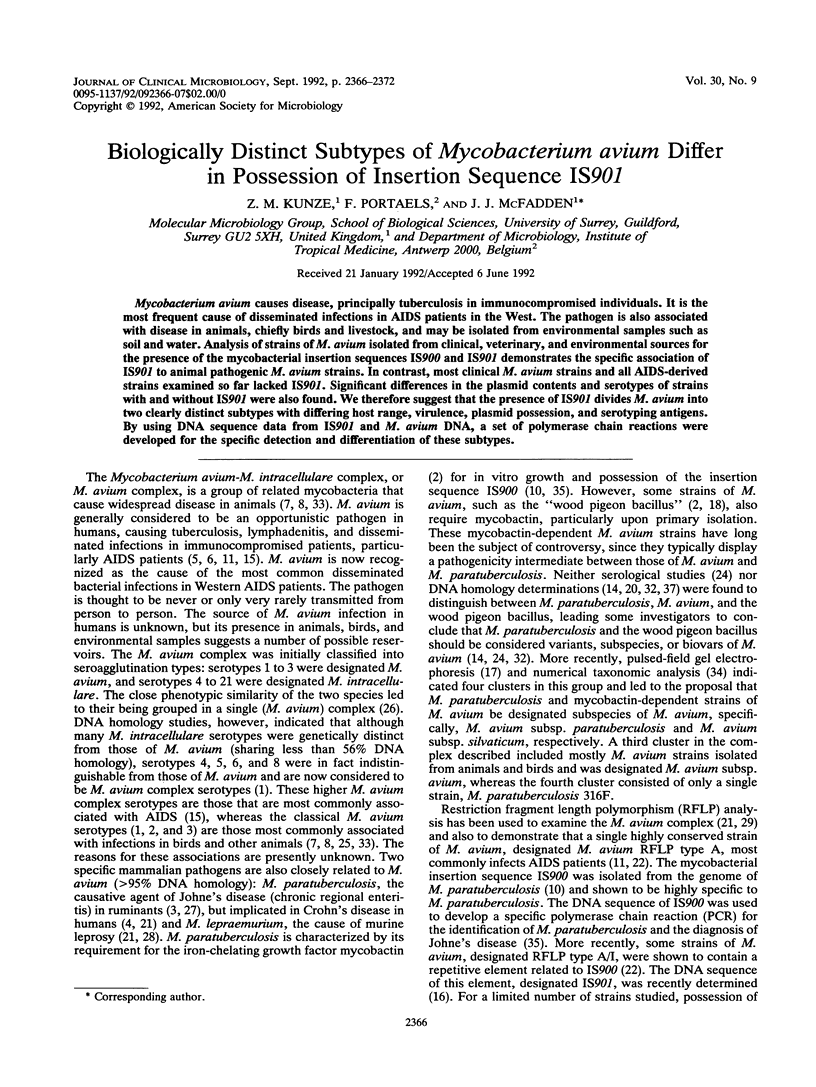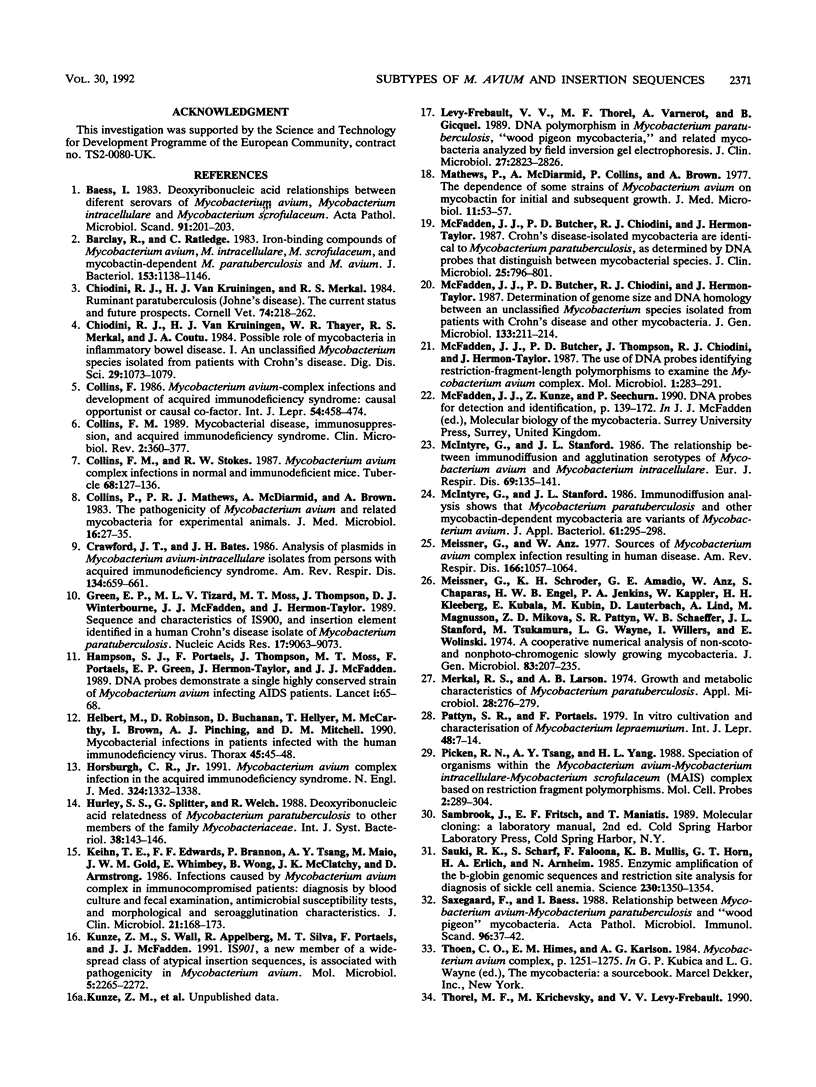Abstract
Mycobacterium avium causes disease, principally tuberculosis in immunocompromised individuals. It is the most frequent cause of disseminated infections in AIDS patients in the West. The pathogen is also associated with disease in animals, chiefly birds and livestock, and may be isolated from environmental samples such as soil and water. Analysis of strains of M. avium isolated from clinical, veterinary, and environmental sources for the presence of the mycobacterial insertion sequences IS900 and IS901 demonstrates the specific association of IS901 to animal pathogenic M. avium strains. In contrast, most clinical M. avium strains and all AIDS-derived strains examined so far lacked IS901. Significant differences in the plasmid contents and serotypes of strains with and without IS901 were also found. We therefore suggest that the presence of IS901 divides M. avium into two clearly distinct subtypes with differing host range, virulence, plasmid possession, and serotyping antigens. By using DNA sequence data from IS901 and M. avium DNA, a set of polymerase chain reactions were developed for the specific detection and differentiation of these subtypes.
Full text
PDF






Images in this article
Selected References
These references are in PubMed. This may not be the complete list of references from this article.
- Baess I. Deoxyribonucleic acid relationships between different serovars of Mycobacterium avium, Mycobacterium intracellulare and Mycobacterium scrofulaceum. Acta Pathol Microbiol Immunol Scand B. 1983 Jun;91(3):201–203. doi: 10.1111/j.1699-0463.1983.tb00033.x. [DOI] [PubMed] [Google Scholar]
- Barclay R., Ratledge C. Iron-binding compounds of Mycobacterium avium, M. intracellulare, M. scrofulaceum, and mycobactin-dependent M. paratuberculosis and M. avium. J Bacteriol. 1983 Mar;153(3):1138–1146. doi: 10.1128/jb.153.3.1138-1146.1983. [DOI] [PMC free article] [PubMed] [Google Scholar]
- Chiodini R. J., Van Kruiningen H. J., Merkal R. S. Ruminant paratuberculosis (Johne's disease): the current status and future prospects. Cornell Vet. 1984 Jul;74(3):218–262. [PubMed] [Google Scholar]
- Chiodini R. J., Van Kruiningen H. J., Thayer W. R., Merkal R. S., Coutu J. A. Possible role of mycobacteria in inflammatory bowel disease. I. An unclassified Mycobacterium species isolated from patients with Crohn's disease. Dig Dis Sci. 1984 Dec;29(12):1073–1079. doi: 10.1007/BF01317078. [DOI] [PubMed] [Google Scholar]
- Collins F. M. Mycobacterial disease, immunosuppression, and acquired immunodeficiency syndrome. Clin Microbiol Rev. 1989 Oct;2(4):360–377. doi: 10.1128/cmr.2.4.360. [DOI] [PMC free article] [PubMed] [Google Scholar]
- Collins F. M. Mycobacterium avium-complex infections and development of the acquired immunodeficiency syndrome: casual opportunist or causal cofactor? Int J Lepr Other Mycobact Dis. 1986 Sep;54(3):458–474. [PubMed] [Google Scholar]
- Collins F. M., Stokes R. W. Mycobacterium avium-complex infections in normal and immunodeficient mice. Tubercle. 1987 Jun;68(2):127–136. doi: 10.1016/0041-3879(87)90028-6. [DOI] [PubMed] [Google Scholar]
- Collins P., Matthews P. R., McDiarmid A., Brown A. The pathogenicity of Mycobacterium avium and related mycobacteria for experimental animals. J Med Microbiol. 1983 Feb;16(1):27–35. doi: 10.1099/00222615-16-1-27. [DOI] [PubMed] [Google Scholar]
- Crawford J. T., Bates J. H. Analysis of plasmids in Mycobacterium avium-intracellulare isolates from persons with acquired immunodeficiency syndrome. Am Rev Respir Dis. 1986 Oct;134(4):659–661. doi: 10.1164/arrd.1986.134.4.659. [DOI] [PubMed] [Google Scholar]
- Green E. P., Tizard M. L., Moss M. T., Thompson J., Winterbourne D. J., McFadden J. J., Hermon-Taylor J. Sequence and characteristics of IS900, an insertion element identified in a human Crohn's disease isolate of Mycobacterium paratuberculosis. Nucleic Acids Res. 1989 Nov 25;17(22):9063–9073. doi: 10.1093/nar/17.22.9063. [DOI] [PMC free article] [PubMed] [Google Scholar]
- Hampson S. J., Portaels F., Thompson J., Green E. P., Moss M. T., Hermon-Taylor J., McFadden J. J. DNA probes demonstrate a single highly conserved strain of Mycobacterium avium infecting AIDS patients. Lancet. 1989 Jan 14;1(8629):65–68. doi: 10.1016/s0140-6736(89)91427-x. [DOI] [PubMed] [Google Scholar]
- Helbert M., Robinson D., Buchanan D., Hellyer T., McCarthy M., Brown I., Pinching A. J., Mitchell D. M. Mycobacterial infection in patients infected with the human immunodeficiency virus. Thorax. 1990 Jan;45(1):45–48. doi: 10.1136/thx.45.1.45. [DOI] [PMC free article] [PubMed] [Google Scholar]
- Horsburgh C. R., Jr Mycobacterium avium complex infection in the acquired immunodeficiency syndrome. N Engl J Med. 1991 May 9;324(19):1332–1338. doi: 10.1056/NEJM199105093241906. [DOI] [PubMed] [Google Scholar]
- Kiehn T. E., Edwards F. F., Brannon P., Tsang A. Y., Maio M., Gold J. W., Whimbey E., Wong B., McClatchy J. K., Armstrong D. Infections caused by Mycobacterium avium complex in immunocompromised patients: diagnosis by blood culture and fecal examination, antimicrobial susceptibility tests, and morphological and seroagglutination characteristics. J Clin Microbiol. 1985 Feb;21(2):168–173. doi: 10.1128/jcm.21.2.168-173.1985. [DOI] [PMC free article] [PubMed] [Google Scholar]
- Kunze Z. M., Wall S., Appelberg R., Silva M. T., Portaels F., McFadden J. J. IS901, a new member of a widespread class of atypical insertion sequences, is associated with pathogenicity in Mycobacterium avium. Mol Microbiol. 1991 Sep;5(9):2265–2272. doi: 10.1111/j.1365-2958.1991.tb02157.x. [DOI] [PubMed] [Google Scholar]
- Lévy-Frébault V. V., Thorel M. F., Varnerot A., Gicquel B. DNA polymorphism in Mycobacterium paratuberculosis, "wood pigeon mycobacteria," and related mycobacteria analyzed by field inversion gel electrophoresis. J Clin Microbiol. 1989 Dec;27(12):2823–2826. doi: 10.1128/jcm.27.12.2823-2826.1989. [DOI] [PMC free article] [PubMed] [Google Scholar]
- Matthews P. R., McDiarmid A., Collins P., Brown A. The dependence of some strains of Mycobacterium avium on mycobactin for initial and subsequent growth. J Med Microbiol. 1978 Feb;11(1):53–57. doi: 10.1099/00222615-11-1-53. [DOI] [PubMed] [Google Scholar]
- McFadden J. J., Butcher P. D., Chiodini R. J., Hermon-Taylor J. Determination of genome size and DNA homology between an unclassified Mycobacterium species isolated from patients with Crohn's disease and other mycobacteria. J Gen Microbiol. 1987 Jan;133(1):211–214. doi: 10.1099/00221287-133-1-211. [DOI] [PubMed] [Google Scholar]
- McFadden J. J., Butcher P. D., Chiodini R., Hermon-Taylor J. Crohn's disease-isolated mycobacteria are identical to Mycobacterium paratuberculosis, as determined by DNA probes that distinguish between mycobacterial species. J Clin Microbiol. 1987 May;25(5):796–801. doi: 10.1128/jcm.25.5.796-801.1987. [DOI] [PMC free article] [PubMed] [Google Scholar]
- McFadden J. J., Butcher P. D., Thompson J., Chiodini R., Hermon-Taylor J. The use of DNA probes identifying restriction-fragment-length polymorphisms to examine the Mycobacterium avium complex. Mol Microbiol. 1987 Nov;1(3):283–291. doi: 10.1111/j.1365-2958.1987.tb01934.x. [DOI] [PubMed] [Google Scholar]
- McIntyre G., Stanford J. L. Immunodiffusion analysis shows that Mycobacterium paratuberculosis and other mycobactin-dependent mycobacteria are variants of Mycobacterium avium. J Appl Bacteriol. 1986 Oct;61(4):295–298. doi: 10.1111/j.1365-2672.1986.tb04290.x. [DOI] [PubMed] [Google Scholar]
- McIntyre G., Stanford J. L. The relationship between immunodiffusion and agglutination serotypes of Mycobacterium avium and Mycobacterium intracellulare. Eur J Respir Dis. 1986 Sep;69(3):135–141. [PubMed] [Google Scholar]
- Meissner G., Anz W. Sources of Mycobacterium avium complex infection resulting in human diseases. Am Rev Respir Dis. 1977 Dec;116(6):1057–1064. doi: 10.1164/arrd.1977.116.6.1057. [DOI] [PubMed] [Google Scholar]
- Meissner G., Schröder K. H., Amadio G. E., Anz W., Chaparas S., Engel H. W., Jenkins P. A., Käppler W., Kleeberg H. H., Kubala E. A co-operative numerical analysis of nonscoto- and nonphotochromogenic slowly growing mycobacteria. J Gen Microbiol. 1974 Aug;83(2):207–235. doi: 10.1099/00221287-83-2-207. [DOI] [PubMed] [Google Scholar]
- Merkal R. S., Curran B. J. Growth and metabolic characteristics of Mycobacterium paratuberculosis. Appl Microbiol. 1974 Aug;28(2):276–279. doi: 10.1128/am.28.2.276-279.1974. [DOI] [PMC free article] [PubMed] [Google Scholar]
- Pattyn S. R., Portaels F. In vitro cultivation and characterization of Mycobacterium lepraemurium. Int J Lepr Other Mycobact Dis. 1980 Mar;48(1):7–14. [PubMed] [Google Scholar]
- Picken R. N., Tsang A. Y., Yang H. L. Speciation of organisms within the Mycobacterium avium-Mycobacterium intracellulare-Mycobacterium scrofulaceum (MAIS) complex based on restriction fragment length polymorphisms. Mol Cell Probes. 1988 Dec;2(4):289–304. doi: 10.1016/0890-8508(88)90013-8. [DOI] [PubMed] [Google Scholar]
- Saiki R. K., Scharf S., Faloona F., Mullis K. B., Horn G. T., Erlich H. A., Arnheim N. Enzymatic amplification of beta-globin genomic sequences and restriction site analysis for diagnosis of sickle cell anemia. Science. 1985 Dec 20;230(4732):1350–1354. doi: 10.1126/science.2999980. [DOI] [PubMed] [Google Scholar]
- Saxegaard F., Baess I. Relationship between Mycobacterium avium, Mycobacterium paratuberculosis and "wood pigeon mycobacteria". Determinations by DNA-DNA hybridization. APMIS. 1988 Jan;96(1):37–42. [PubMed] [Google Scholar]
- Vary P. H., Andersen P. R., Green E., Hermon-Taylor J., McFadden J. J. Use of highly specific DNA probes and the polymerase chain reaction to detect Mycobacterium paratuberculosis in Johne's disease. J Clin Microbiol. 1990 May;28(5):933–937. doi: 10.1128/jcm.28.5.933-937.1990. [DOI] [PMC free article] [PubMed] [Google Scholar]
- Wendt S. L., George K. L., Parker B. C., Gruft H., Falkinham J. O., 3rd Epidemiology of infection by nontuberculous Mycobacteria. III. Isolation of potentially pathogenic mycobacteria from aerosols. Am Rev Respir Dis. 1980 Aug;122(2):259–263. doi: 10.1164/arrd.1980.122.2.259. [DOI] [PubMed] [Google Scholar]
- Yoshimura H. H., Graham D. Y. Nucleic acid hybridization studies of mycobactin-dependent mycobacteria. J Clin Microbiol. 1988 Jul;26(7):1309–1312. doi: 10.1128/jcm.26.7.1309-1312.1988. [DOI] [PMC free article] [PubMed] [Google Scholar]




